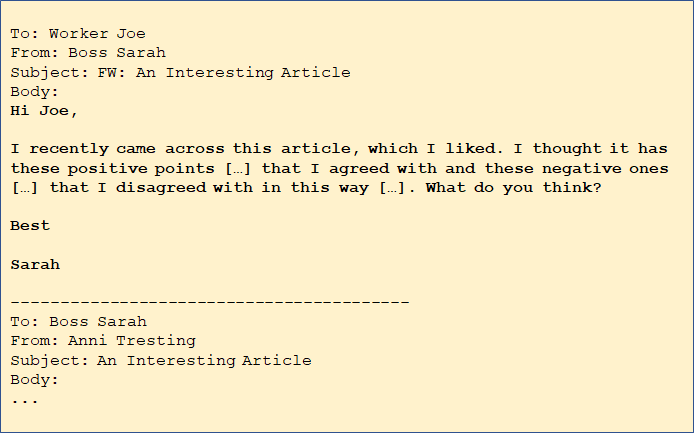
Let’s face it, email is a terrible communication medium!
Anyone who has been on our 3-day product management and product marketing course knows that we like the comedy video about a ‘conference call in real life’. Recently we also came across an ‘email in real life‘ version by the same team that we wanted to share with you below. Look out for the ‘Administrator’!
Do you think about email best practice?
There are many ways in which email (or how we use it) is broken. Here are a few of my favorite issues with it.
Lost in transfer
Many people don’t realize, but the words we use are only about 20% of what we communicate. That’s right 80% of what you communicate comes from other sources such as tone of voice or body language. Think about that, email is losing 80% of the information!
We also forget that language is imprecise. What a word means to the writer may not be the same as it means to the reader. We use idioms, similes, and metaphors to try to explain things but that relies on a shared mental ‘library’ of them. Especially when talking across cultural boundaries, this is often not the case.
The machine is in control
How many emails do you get a day? I know I reached my peak a couple of years ago at about 300. Yes, you read that correctly 300!
No one can handle that many emails and do some work that adds value.
To stay sane, I just accepted that I could not live that way anymore. So I turned off notifications and changed the way I worked so that messages got handled on ‘my’ schedule – when it was convenient for me. And yet scarily some people consider themselves to be productive because they ‘handle’ all of their emails!
I also remember the days when 5-10 emails was a busy day. It’s not that long ago, only in the early 2000s. At that time, we weren’t all merely email responding machines. But today in the corporate world that seems to be the reality. Our smartphone goes ‘buzz’ or our computer goes ‘bing’, and we jump to check the latest incoming mail.
The multiplier effect and inverse productivity
Have you ever noticed that for every email you send you receive 2-3 more back? That’s right. ‘You’ are the source of your slavery to email.
I experimented a few years ago where I started sending fewer emails and instead switched to other tools like the good old phone. Guess what – the number of emails I got back went down! Not only that but the speed at which things got done went up!
Ping-pong
How many of you have had a conversation via email? Sending messages back and forth to your colleagues in a virtual game of ping-pong. I bet most of us have. We have come to think of it as real-time but it’s not.
It’s also not very efficient.
How many of you can type as quickly as you can speak? It’s far harder and slower to probe and discuss with an email conversation but because it is easy to ‘fire and forget’ we draw out a short discussion over hours if not days by email. That also means that the action from the exchange is delayed by hours or days!
Copy the world (or at least our bosses)
Not only do we send them back and forward. We interrupt other people with this dialogue, most often our bosses.
I am sure you have heard the phrase ‘why have a dog and bark yourself?’. One of the reasons your boss employs you is for you to do some work, so they don’t have to. If we include them in all of these discussions, they could have (almost) done it themselves.
This one seems to be rooted in people wanting to demonstrate (or prove) that they are working hard and contributing. Or in the worst-case ‘covering their backs’ which suggests they are not empowered or trusted.
Remember for your boss this is another multiplier because if everyone who works for them does this, they get all of their emails as well!
I used to actively reduce the Cc list to only people who were needed, only to find that people would re-add the people I took off. It came to the point that I needed to explicitly state why I was dropping them at the start to have a chance of it holding.
No one reads long emails
It’s true. If you write more than a few lines, people scan the content at best, but they don’t truly read and digest the material.
People also have a habit of putting all the background information first then the decision or action required last, which makes it worse. By the time people get there (if they get there) they are likely to miss it. I even came across someone recently who used to reply to long emails with TLDR (Too Long, Didn’t Read)!
Have you ever seen an email by successful people? If not, hint, they are short.
Where an average person might write something like the following:
A highly effective person, on the other hand, would likely say something much shorter such as:
Fundamentally in this way (1) The information is shared. (2) The action is clear. (3) There is no bias introduced by providing the sender’s opinion. And (4) most important of all, it is quicker for both sides.
‘I just sent you an email’
Last, my personal biggest pet hate – when someone gets stuck in the email mindset.
They write you an email, then either walk over or pick up the phone, and say “I just sent you an email”.
People who do this really, really want you to handle it immediately. There is no consideration of your workload or other commitments.
My typical response was “and?” because unless there is a specific justification for needing me to take quick action I will get to it when (or if) I can. If it is that urgent why did they waste time writing an email instead of walking over to me (or calling me) directly?
Power Tips
To overcome these and other issues associated here are a few power tips that might help you be more productive – some email best practice :
1. Create some email rules, including:
a. What to use email for (versus other tools like IM and texting)
b. Choose a single channel for the message (e.g. just email)
c. Add response time expectations
d. Be clear on when to Reply / Reply to All / Cc / Bcc
2. Create guidelines for the structure of emails, including:
a. Subject line contents
b. Keep it short
c. Keep the language simple
d. Actions or decisions at the beginning
e. Background information later
3. Turn off notifications (mobile and desktop) so you’re not distracted and go to emails when you’re ready
Some further thoughts…
Sending the same message multiple ways can make the recipient feel like they are being attacked. Making them feel that way will probably make them less likely to help you or care about your message.
Does anyone still use Bcc? I know I stopped a long time ago. Many organizations have even banned it because it is seen as going behind people’s backs.
Getting the subject line right can be a really powerful tool to help people know how to handle things. At my previous company, our internal consultancy team developed some guidelines that I applied with great success. The key elements of which are:
1. Tell them if it’s just Information, an action to be done or if a decision is required
2. Follow with the product (or project)
3. Finally, write a short, but clear, description of the content e.g. Info – Project Nexus – New Insights about the Competition
My colleague uses a simpler version, he starts messages with FYI so that people know it’s not time-critical. Simple is often most effective so use what works for you.
Wrap-Up
I am not saying that you directly have the power to change the email culture of your organization, but you can influence it. It is powerful to be seen as someone who is highly effective. Getting the rules right for how you manage your time and communication channels can be a significant contributor to that.
But Email is not destined to be thrown on the rubbish heap just yet. It is a great medium when used correctly. It is great for communicating information and excellent for consistently reaching a broad audience, especially across time zones. Try some of my email best practice ideas to make it work better for you.
Phil Hornby
Independent Consultant




Join the conversation - 6 replies
I hate receiving an email with just the word ‘Thoughts’. It’s as if they’re abdicating their part of the conversation and expecting me to do all the work. Coming to a consensus and building an informed picture, particularly over multiple time-zones, requires participation.
I am not suggesting not taking part in the conversation. However, e-mail is not a great medium for a conversation even across timezones in my opinion.
When I first received e-mails like this I also didn’t like them. Until I had the realisation that they were actually empowering. Too many people lead off with their opinions. It biased the entire discussion before it starts. Especially when coming from someone in a leadership position, it stops the discussion from creating the value it could do.
To quote Stephen Covey, one habit of highly effective people is “Seek first to understand, then be understood.” So I advocate gathering other people’s thoughts before providing your own opinion, or drawing conclusions. You can ask that in a longer form, but the outcome is the same, and it takes more of your (valuable) time.
As a last thought, there are cultural considerations you may make. In the UK we tend to favour less direct and more polite language. Whereas US and German colleagues would likely be much happier with the more direct approach. With varying mileage in other cultures.
We recently introduced the habit to move any recipient we feel is not needed on an email chain to BCC. With that they realise that they have been taken off and could take a potential action only if needed. This helped a lot to significantly reduce email chains with a ton of recipients that would not even care and gives those taken off a chance to react as needed.
Hi Stefan, that is an interesting convention. I can see how it would work, as long as it is a known rule it should avoid the issue of being seen as going behind people’s backs as the people on Bcc are already on the thread. It would certainly help reduce the impact of “Reply to All”.
To me, BCC is a mistake waiting to happen with colleagues who might reply with content or information that isn’t best shared across everyone in cc . With people working at a rapid pace, multi-tasking and on their phone, they could easily hit reply and not realize they were in BCC and the email goes out to everyone! I’ve seen it happen and I feel that by simply refraining from its use, is a good policy. It is much better to recap the content verbally and/or in separate email or use the forward function to achieve the same thing for the BCC function.
Hi Elizabeth – Bcc adds no more danger than Cc in that sense. With a clear use case of removing people from a thread by calling that our right at the start of the mail it actually reduced the risk in my experience not increases it. Obviously, any use of Bcc is contentious, but this works! It also has the added advantage of reducing the e-mail load hitting leader’s inboxes, which means they can give more attention to the ones they do get.